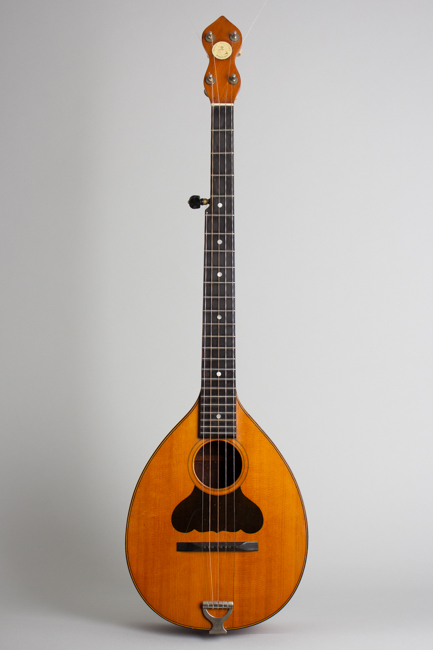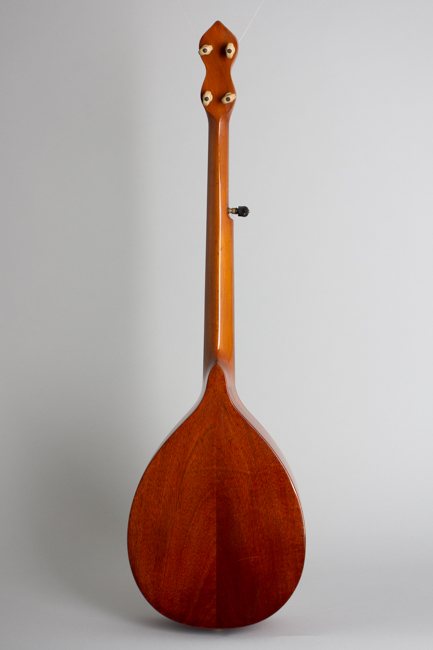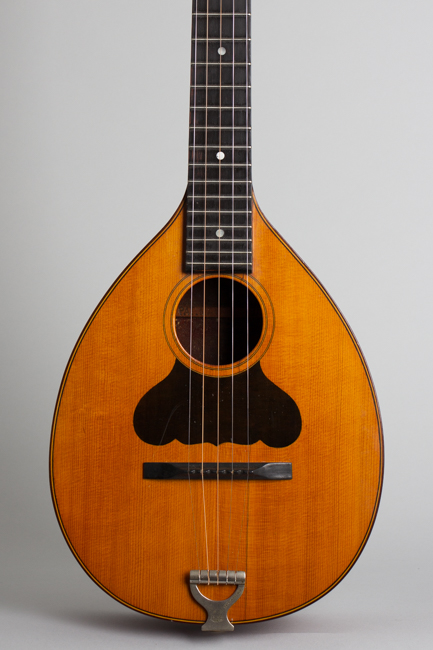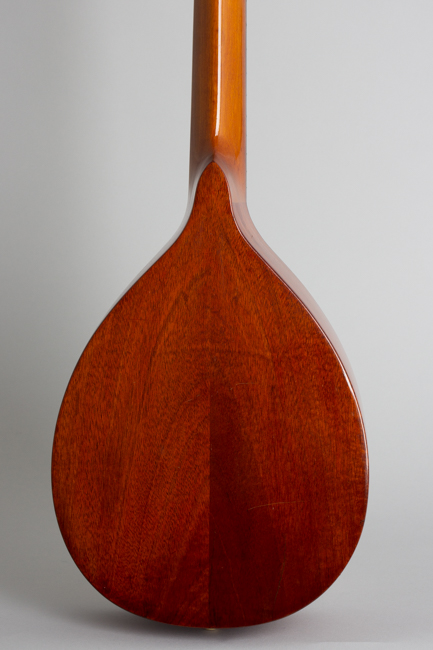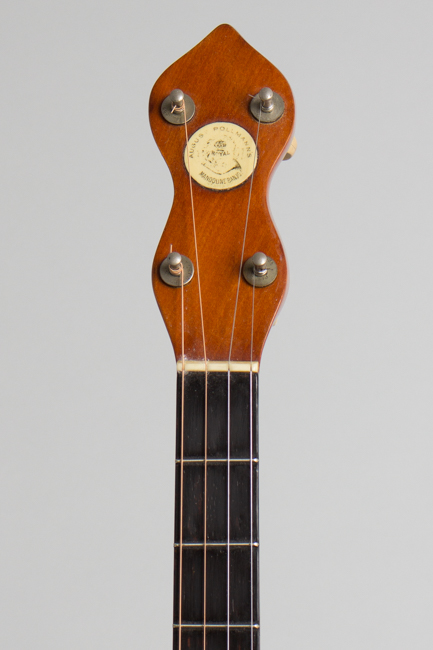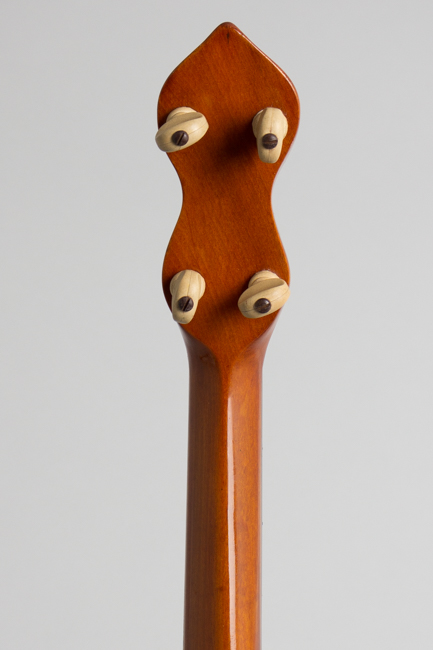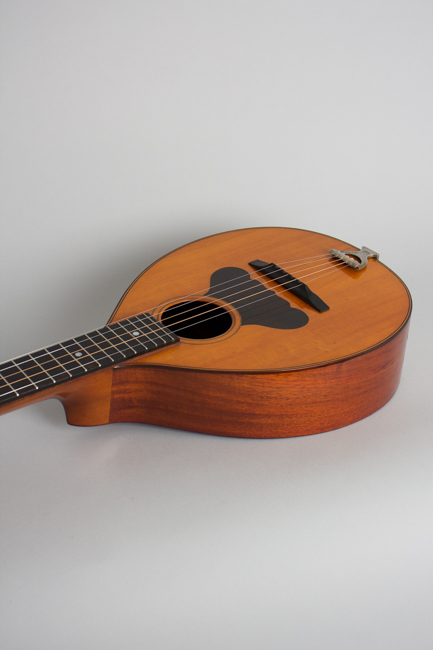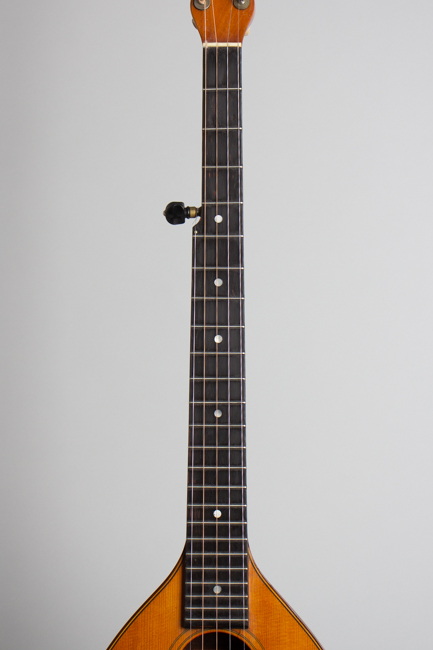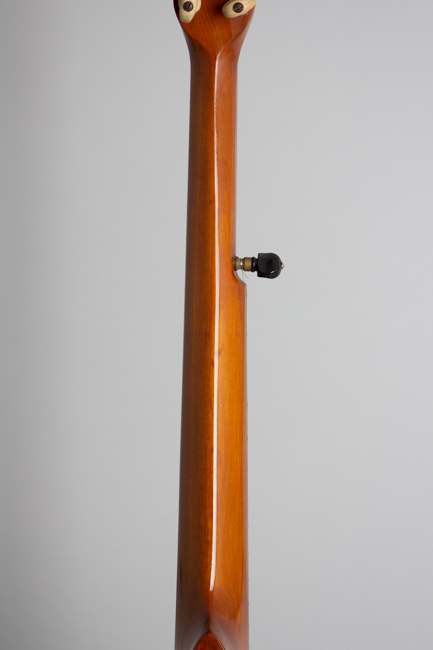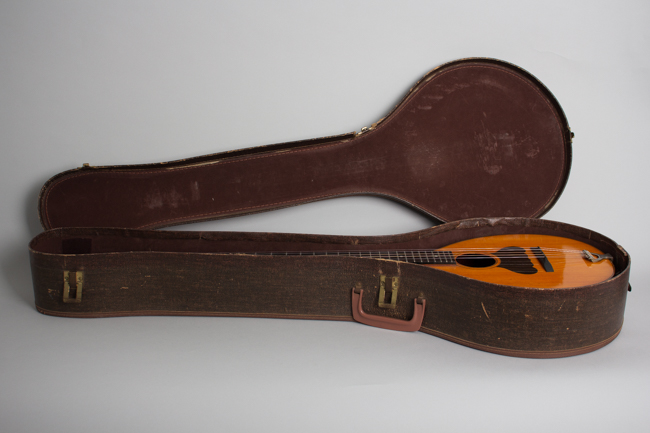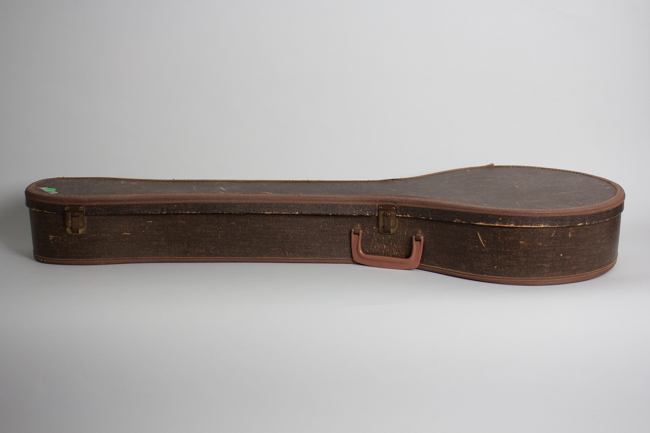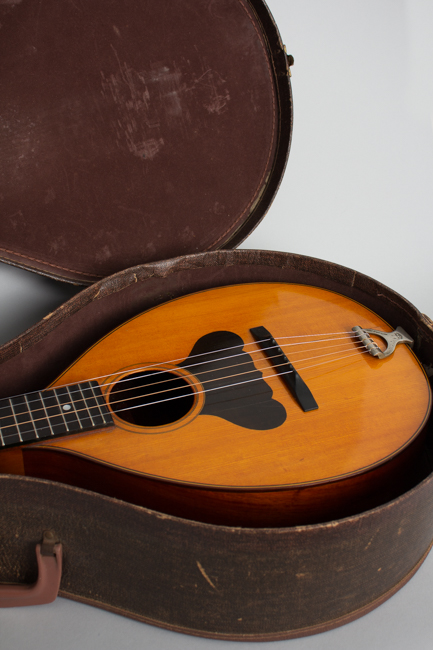August Pollmann Royal Mandolin Banjo , c. 1890
This item has been sold.
Item # 10502
Prices subject to change without notice.
August Pollmann Royal Model Mandolin Banjo, c. 1890, made in USA, natural varnish finish, spruce top, mahogany back and sides, ebonized fretboard, brown chipboard case.
This Pollman Royal Mandolin Banjo represents one of the more unusual crossbreeding experiments in American Lutherie. The instrument consists of a five-string banjo-style neck mounted on a flat-topped wooden body roughly the size and shape of a mandola. A product of the late nineteenth century boom in both banjos and mandolins, this hybrid makes a claim to being both at once! Tuned and played like a 5-string banjo, it has a delicate and enchanting sound more like a small guitar or lute.
These are thought to have been made for August Pollman's New York based company by Pehr Anderberg, a Swedish-born luthier who also worked for Bay State in Boston. They are superbly made using high quality materials and construction details throughout. This is the most basic model offered, unadorned but every bit as well made as the higher end models. The solid spruce ladder-braced top is bound with triple-layered wood marquetry, the soundhole rings are discreet wood as well. It carries a plain mandolin-like inlaid pickguard. The back and sides of the vaguely pear shaped body are mahogany, the neck appears to be maple or poplar finished dark, with a dot-inlaid ebonized fingerboard.
A brand on the backbrace reads "Pat. May 3, 1887". The metal trapeze tailpiece reads "WM. GERKE, Prov. R.I., Pat'd Jan. 31. 1888". Inlayed in the headstock is an ivoroid disk with "August Pollman's ROYAL Mandolin Banjo" and the patent date. Beautifully made but somewhat delicate, these Pollmans are hard to find in solid playable shape. One was famously used in a prop in noted photographer Alfred Cheney Johnson's studio in the 1920's, gradually sinking into decrepitude as it appears in many of his portraits of the beautiful Ziegfeld girls! This plain model has survived with some old rebuilding playing and sounding excellent, a fun instrument for the turn-of-the (last) century banjo enthusiast or anyone looking for a truly unique sound. Overall this is a plain but nice player's example of this delightful oddity.
Overall length is 34 1/8 in. (86.7 cm.), 10 3/8 in. (26.4 cm.) wide at lower bout, and 3 9/16 in. (9 cm.) in depth at side, taken at the end block. Scale length is 23 3/4 in. (584 mm.). Width of nut is 1 5/16 in. (33 mm.).
This is a very playable instrument, even surprisingly so for being something in the neighborhood of 130 years old. It has seen some older work typical of many of these. The original varnish was overcoated long ago with a newer thin topcoat, something older banjo enthusiasts were particularly prone to doing 50 or so years back. It shows very little wear since save for some minor scuffs and dings and one scratch on the top in front of the bridge.
There are some old repaired cracks on the instrument; the most notable is a long grain split on the top running from the back edge to the pickguard just below the highest string, sealed long ago but quite visible. The soundhole rim has a couple of short grain splits, one running to the fingerboard and the other to the pickguard edge. There are two more jagged cracks on the back, off the rear edge. All these look to have been sealed up decades ago, likely before the finish work.
There is a mahogany underlay beneath the original fingerboard which we would assume was added long ago, though the wonk is very neat if so. This makes the neck a bit chunkier than it would have been, but also fully capable of handling steel stringing. The fingerboard and thin wire frets appear original, as are the tuners and tailpiece. The celluloid disc on the headstock has minor loss to the stenciling but has not shrunken and fallen out as many have. The wooden bridge is a hand-made piece with some age to it but not original, likewise the bone nut.
Despite the foregoing catalog of repair and modifications this Royal Mandoline Banjo is still something of a miraculous survivor of the late 19th century; not too many of these rather fragile instruments survive in playable condition at all. This one plays very well with steel strings offering a truly enchanting sound; it is housed in an older chipboard banjo case replacing whatever lost canvas or leather case it might have had long ago. Overall Very Good + Condition.
This Pollman Royal Mandolin Banjo represents one of the more unusual crossbreeding experiments in American Lutherie. The instrument consists of a five-string banjo-style neck mounted on a flat-topped wooden body roughly the size and shape of a mandola. A product of the late nineteenth century boom in both banjos and mandolins, this hybrid makes a claim to being both at once! Tuned and played like a 5-string banjo, it has a delicate and enchanting sound more like a small guitar or lute.
These are thought to have been made for August Pollman's New York based company by Pehr Anderberg, a Swedish-born luthier who also worked for Bay State in Boston. They are superbly made using high quality materials and construction details throughout. This is the most basic model offered, unadorned but every bit as well made as the higher end models. The solid spruce ladder-braced top is bound with triple-layered wood marquetry, the soundhole rings are discreet wood as well. It carries a plain mandolin-like inlaid pickguard. The back and sides of the vaguely pear shaped body are mahogany, the neck appears to be maple or poplar finished dark, with a dot-inlaid ebonized fingerboard.
A brand on the backbrace reads "Pat. May 3, 1887". The metal trapeze tailpiece reads "WM. GERKE, Prov. R.I., Pat'd Jan. 31. 1888". Inlayed in the headstock is an ivoroid disk with "August Pollman's ROYAL Mandolin Banjo" and the patent date. Beautifully made but somewhat delicate, these Pollmans are hard to find in solid playable shape. One was famously used in a prop in noted photographer Alfred Cheney Johnson's studio in the 1920's, gradually sinking into decrepitude as it appears in many of his portraits of the beautiful Ziegfeld girls! This plain model has survived with some old rebuilding playing and sounding excellent, a fun instrument for the turn-of-the (last) century banjo enthusiast or anyone looking for a truly unique sound. Overall this is a plain but nice player's example of this delightful oddity.
Overall length is 34 1/8 in. (86.7 cm.), 10 3/8 in. (26.4 cm.) wide at lower bout, and 3 9/16 in. (9 cm.) in depth at side, taken at the end block. Scale length is 23 3/4 in. (584 mm.). Width of nut is 1 5/16 in. (33 mm.).
This is a very playable instrument, even surprisingly so for being something in the neighborhood of 130 years old. It has seen some older work typical of many of these. The original varnish was overcoated long ago with a newer thin topcoat, something older banjo enthusiasts were particularly prone to doing 50 or so years back. It shows very little wear since save for some minor scuffs and dings and one scratch on the top in front of the bridge.
There are some old repaired cracks on the instrument; the most notable is a long grain split on the top running from the back edge to the pickguard just below the highest string, sealed long ago but quite visible. The soundhole rim has a couple of short grain splits, one running to the fingerboard and the other to the pickguard edge. There are two more jagged cracks on the back, off the rear edge. All these look to have been sealed up decades ago, likely before the finish work.
There is a mahogany underlay beneath the original fingerboard which we would assume was added long ago, though the wonk is very neat if so. This makes the neck a bit chunkier than it would have been, but also fully capable of handling steel stringing. The fingerboard and thin wire frets appear original, as are the tuners and tailpiece. The celluloid disc on the headstock has minor loss to the stenciling but has not shrunken and fallen out as many have. The wooden bridge is a hand-made piece with some age to it but not original, likewise the bone nut.
Despite the foregoing catalog of repair and modifications this Royal Mandoline Banjo is still something of a miraculous survivor of the late 19th century; not too many of these rather fragile instruments survive in playable condition at all. This one plays very well with steel strings offering a truly enchanting sound; it is housed in an older chipboard banjo case replacing whatever lost canvas or leather case it might have had long ago. Overall Very Good + Condition.
